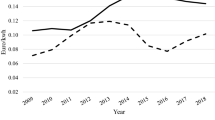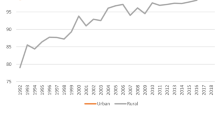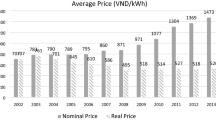Abstract
This paper develops a pseudo-panel approach to examine household electricity demand behavior through the household life cycle and its response to income variations to help strengthen the energy policy-making process. Our empirical methodology is based on three rich independent microdata surveys (the National Housing Surveys), which are representative of the French housing sector. The resulted sample covers the 2006–2016 period. Using within estimations, this paper finds striking evidence that the income elasticity of French residential electricity demand is 0.22, averaged over our four cohorts of generations. In light of other works, our estimate stands in the lower range. The empirical results also show that residential electricity consumption follows an inverted U-shaped distribution as a function of the age of the household’s head. Most notably, it appears that households at the mid-point of their life cycle are relatively the largest consumers of electricity. This outcome has important implications for policy-making. Any public policy aimed at reducing household energy consumption should consider this differentiation in consumption according to the position of households over the life cycle, and therefore target as priority households at the highest level of consumption.



Similar content being viewed by others
Notes
These are the three most recent waves of the survey.
According to the OECD scale, weights in consumption units are 1 for the first adult, 0.5 for each subsequent adult and 0.3 for each child in the household, where a child is defined as a person under 14 years old.
References
Abrahamse W, Steg L (2009) How do socio-demographic and psychological factors relate to households' direct and indirect energy use and savings? J Econ Psychol 30(5):711–720
Alter N, Syed SH (2011) An empirical analysis of electricity demand in Pakistan. Int J Energy Econ Policy 1(4):116–139
Bakaloglou S, Charlier D (2018) Energy consumption in the French residential sector: how much do individual preferences matter? Working papers, 1803, Chaire Economie du climat
Baltagi B (2005) Econometric analysis of panel data, 3rd edn
Bardazzi R, Pazienza MG (2017) Switch off the light, please! Energy use, aging population and consumption habits. Energy Econ 65:161–171. https://doi.org/10.1016/j.eneco.2017.04.025
Bedir M, Hasselaar E, Itard L (2013) Determinants of electricity consumption in Dutch dwellings. Energy Build 58:194–207. https://doi.org/10.1016/j.enbuild.2012.10.016
Belaïd F (2016) Understanding the spectrum of domestic energy consumption: empirical evidence from France. Energy Policy 92:220–233. https://doi.org/10.1016/j.enpol.2016.02.015
Belaïd F (2017) Untangling the complexity of the direct and indirect determinants of the residential energy consumption in France: quantitative analysis using a structural equation modeling approach. Energy Policy 110:246–256
Belaïd F (2018) Exposure and risk to fuel poverty in France: examining the extent of the fuel precariousness and its salient determinants. Energy Policy 114:189–200
Belaïd F, Garcia T (2016) Understanding the spectrum of residential energy-saving behaviours: French evidence using disaggregated data. Energy Econ 57:204–214
Belaïd F, Bakaloglou S, Roubaud D (2018) Direct rebound effect of residential gas demand: empirical evidence from France. Energy Policy 115:23–31
Belaïd F, Roubaud D, Galariotis E (2019) Features of residential energy consumption: evidence from France using an innovative multilevel modelling approach. Energy Policy 125:277–285
Belaïd F, Joumni H (2020) Behavioral attitudes towards energy saving: Empirical evidence from France. Energy Policy 140:111406
Belaïd F, Youssef AB, Lazaric N (2020a) Scrutinizing the direct rebound effect for French households using quantile regression and data from an original survey. Ecol Econ 176:106755
Belaïd F, Youssef AB, Omrani N (2020b) Investigating the factors shaping residential energy consumption patterns in France: evidence form quantile regression. Eur J Comp Econ 17(1):127–152. https://doi.org/10.25428/1824-2979/202001-127-151
Belaïd F, Ranjbar Z, Massié C (2021) Exploring the cost-effectiveness of energy efficiency implementation measures in the residential sector. Energy Policy 150:112122
Belaïd F and Rault C (2021) Energy Expenditure in Egypt: Empirical Evidence Based on a Quantile Regression Approach. Environ Model Assess. https://doi.org/10.1007/s10666-021-09764-8
Bernard JT, Bolduc D, Belanger D (1996) Quebec residential electricity demand: a microeconometric approach. Can J Econ 29(1):92–113. https://doi.org/10.2307/136153
Bernard JT, Bolduc D, Yameogo ND (2011) A pseudo-panel data model of household electricity demand. Resour Energy Econ 33:315–325. https://doi.org/10.1016/j.reseneeco.2010.07.002
Bodier M (1999) Les effets d'âge et de génération sur le niveau et la structure de la consommation. Econ Stat 324-325:163–180
Breusch TS, Pagan AR (1979) A simple test for heteroscedasticity and random coefficient variation. Econometrica 47(5):1287–1294. https://doi.org/10.2307/1911963
Brounen D, Kok N, Quigley JM (2012) Residential energy use and conservation: Economics and demographics. Eur Econ Rev 56(5):931–945. https://doi.org/10.1016/j.euroecorev.2012.02.007
Chalal ML, Benachir M, White M, Shahtahmassebi G, Cumberbatch M, Shrahily R (2017) The impact of the UK household life-cycle transitions on the electricity and gas usage patterns. Renew Sust Energ Rev 80:505–518. https://doi.org/10.1016/j.rser.2017.05.222
Commissariat général au développement durable (2015) Chiffres et statistiques, Consommations énergétiques des ménages en 2012. https://www.statistiques.developpement-durable.gouv.fr/sites/default/files/2018-10/chiffres-stats645-conso-energetiques-des-menages2012-juin2015.pdf. Accessed Dec 2020
Commissariat général au développement durable (2019). Chiffres clés de l’énergie, Édition 2019. https://www.statistiques.developpement-durable.gouv.fr/sites/default/files/2019-09/datalab-59-chiffres-cles-energie-edition-2019-septembre2019.pdf. Accessed Dec 2020
CREDOC (2008) Enquête "Conditions de vie et Aspirations des Français", Quelques opinions et aspirations en matière de logement. https://www.credoc.fr/publications/enquete-conditions-de-vie-et-aspirations-des-francais-quelques-opinions-et-aspirations-en-matiere-de-logement. Accessed May 2020
Csereklyei Z (2020) Price and income elasticities of residential and industrial electricity demand in the European Union. Energy Policy 137. https://doi.org/10.1016/j.enpol.2019.111079
De Abreu Pereira Uhra D, Squarize Chagas AL, Galeggo Ziero Uhr J (2019) Estimation of elasticities for electricity demand in Brazilian households and policy implications. Energy Policy 129:69–79. https://doi.org/10.1016/j.enpol.2019.01.061
Deaton A (1985) Panel data from time series of cross sections. J Econ 30:109–126. https://doi.org/10.1016/0304-4076(85)90134-4
Dolling J (1975) The family life cycle and housing choice. Urban Stud 13:55–58
Dubin JA, McFadden DL (1984) An econometric analysis of residential electricity appliance holdings and consumption. Econometrica 52(2):345–362. https://doi.org/10.2307/1911493
EDF (2020) L’électricité dans le secteur résidentiel. https://www.edf.fr/groupe-edf/espaces-dedies/l-energie-de-a-a-z/tout-sur-l-energie/le-developpement-durable/l-electricite-dans-le-secteur-residentiel. Accessed May 2020
Estiri H, Zagheni E (2019) Age matters: ageing and household energy demand in the United States. Energy Res Soc Sci 55:62–70. https://doi.org/10.1016/j.erss.2019.05.006
Eurostat (2016) Simplified Balance Electricity Heat ktoe EU-28 - Statistics Explained, 2016. https://ec.europa.eu/eurostat/statistics-explained/index.php?title=File:Simplified-balance-electricity-heat-ktoe-EU-28-2016.png. Accessed Jan 2020
Eurostat (2018a) Births and fertility in 2016.https://ec.europa.eu/eurostat/documents/2995521/8774296/3-28032018-AP-EN.pdf/fdf8ebdf-a6a4-4153-9ee9-2f05652d8ee0. Accessed Dec 2020
Eurostat (2018b) Bye bye parents: when do young Europeans flee the nest? https://ec.europa.eu/eurostat/web/products-eurostat-news/-/EDN-20180515-1. Accessed Dec 2020
Fritzsche DJ (1981) An analysis of energy consumption patterns by stage of family life cycle. J Mark Res 18(2):227–232. https://doi.org/10.2307/3150956
Gardes F, Duncan GJ, Gaubert P, Gurgand M, Starzec C (2005) Panel and pseudo-panel estimation of cross-sectional and time series elasticities of food consumption: the case of American and polish data. J Bus Econ Stat 23(2):242–253
Gomez L, Blázquez M, Filippini M, Heimsch F (2013) Regional impact of changes in disposable income on Spanish electricity demand: a spatial econometric analysis. Energy Econ 40:58–66. https://doi.org/10.1016/j.eneco.2013.09.008
Hausman JA (1978) Specification tests in econometrics. Econometrica 46(6):1251–1271
Huebner GM, Shipworth D (2017) All about size? – the potential of downsizing in reducing energy demand. Appl Energy 186:226–233. https://doi.org/10.1016/j.apenergy.2016.02.066
Huebner GM, Hamilton I, Chalabi Z, Shipworth D, Oreszczyn T (2015) Explaining domestic energy consumption - the comparative contribution of building factors, socio-demographics, behaviours and attitudes. Appl Energy 159:589–600
INSEE (2017a) Les conditions de logement en France, édition 2017.https://www.insee.fr/fr/statistiques/2586377. Accessed Dec 2020
INSEE (2017b) Un premier enfant à 28,5 ans en 2015 : 4,5 ans plus tard qu’en 1974. https://www.insee.fr/fr/statistiques/2668280#tableau-figure1. Accessed Dec 2020
INSEE (2019) Tableaux de l'économie française, Édition 2019. https://www.insee.fr/fr/statistiques/3676661?sommaire=3696937. Accessed Dec 2020
Jamil F, Ahmad E (2011) Income and price elasticities of electricity demand: aggregate and sector-wise analyses. Energy Policy 39(9):5519–5527
Jappelli T, Modigliani F (1998) The age-saving profile and the life-cycle hypothesis. Center for studies in economics and finance, working paper no.9. https://EconPapers.repec.org/RePEc:sef:csefwp:09
Jones RV, Fuertes A, Lomas KJ (2015) The socio-economic, dwelling and appliance related factors affecting electricity consumption in domestic buildings. Renew Sust Energ Rev 43:901–917. https://doi.org/10.1016/j.rser.2014.11.08
Lévy JP, Belaïd F (2018) Les modèles de consommation énergétique des bâtiments, Limites et perspectives, Rapport final. ChaireEco-Conception. https://hal-enpc.archives-ouvertes.fr/hal-02014175/document
Lévy JP, Roudil N, Flamand A, Belaïd F (2014) The determinants of domestic energy consumption. Flux 2:40–54
Longhi S (2015) Residential energy expenditures and the relevance of changes in household circumstances. Energy Econ 49:440–450. https://doi.org/10.1016/j.eneco.2015.03.018
Miller M, Alberini A (2016) Sensitivity of price elasticity of demand to aggregation, unobserved heterogeneity, price trends, and price endogeneity: evidence from U.S. data. Energy Policy 97:235–249. https://doi.org/10.1016/j.enpol.2016.07.031
Modigliani F (1966) The life cycle hypothesis of saving, the demand for wealth and the supply of capital. Soc Res 33(2):160–217 https://www.jstor.org/stable/40969831
Moffitt R (1993) Identification and estimation of dynamic models with a time series of repeated cross-sections. J Econ 59:99–123. https://doi.org/10.1016/0304-4076(93)90041-3
Mundlak Y (1978) On the pooling of time series and cross-section data. Econometrica 46(1):69–85
Nijman T, Verbeek M (1992a) Nonresponse in panel data: the impact on estimates of a life cycle consumption function. J Appl Econ 7(3):243–257. https://doi.org/10.1002/jae.3950070303
Nijman T, Verbeek M (1992b) Testing for selectivity Bias in panel data models. Int Econ Rev 33(3):681–703. https://doi.org/10.2307/2527133
Ota T, Kakinaka M, Kotani K (2018) Demographic effects on residential electricity and city gas consumption in the aging society of Japan. Energy Policy 115:503–513
Ramsey JB (1969) Tests for specification errors in classical linear least-squares regression analysis. J R Stat Soc Series B (Methodological) 31(2):350–371
Shulte I, Heindl P (2017) Price and income elasticities of residential energy demand in Germany. Energy Policy 102:512–528. https://doi.org/10.1016/j.enpol.2016.12.055
Stephan A, Crawford RH (2016) The relationship between house size and life cycle energy demand: implications for energy efficiency regulations for buildings. Energy 116:1158–1171
Wooldridge JM (2012) Introductory econometrics: A modern approach (fifth international edition). Chapter 14, advanced panel data methods, 484-511
York R (2007) Demographic trends and energy consumption in European Union nations, 1960–2025. Soc Sci Res 36(3):855–872. https://doi.org/10.1016/j.ssresearch.2006.06.007
Zhou S, Teng F (2013) Estimation of urban residential electricity demand in China using household survey data. Energy Policy 61:394–402. https://doi.org/10.1016/j.enpol.2013.06.092
Author information
Authors and Affiliations
Corresponding author
Ethics declarations
Conflict of interest
The authors have no conflicts of interest to declare that are relevant to the content of this article.
Additional information
Publisher’s note
Springer Nature remains neutral with regard to jurisdictional claims in published maps and institutional affiliations.
Appendix
Appendix
1.1 A. Hausman test for cohort 1
The Hausman test permits to choose between fixed effects and random effects. The null hypothesis is that the two estimation methods are both suitable and deliver consistent estimators, which should therefore yield similar coefficients, whereas the alternative hypothesis is that fixed effects are suitable but not random effects. If this is the case, differences between the two sets of coefficients would be expected. A large and significant Hausman statistics means a large and significant difference (Hausman 1978).
Table 7
Here, for cohort 1, the Hausman test statistics is found at 19.92 and is statistically significant (p value of zero). Therefore, the null hypothesis that the two methods are suitable is rejected in favor of the alternative hypothesis that fixed effects are suitable and random effects are not.
1.2 B. Mundlak test for cohort 1
The Mundlak test permits to check the validity of the assumptions on which random effects are based upon, being that there is no correlation between time-invariant effects and regressors. The null hypothesis states that the panel-level averages of time-varying covariates are jointly zero and the alternative hypothesis states that at least one of the panel-level averages is different from zero. The test follows a three-step procedure:
-
Compute the panel-level average of time-varying covariates;
-
Regress the dependent variable on the set of covariates and their panel-level averages with random effects;
-
Compute the test-statistics and conclude.
If the null hypothesis is rejected, i.e., that panel-level averages are not jointly zero, then it indicates that there is a correlation between the time-invariant unobservable and other covariates. In this case, the violation of the hypothesis on which random effects are based upon implies the inconsistency of random-effects parameters. Therefore, the fixed effects should be favored (Mundlak 1978).
Here, for eq. (4) estimated on cohort 1, the test statistics of 28.83 is large and statistically significant (p value of zero), so the null hypothesis that panel-level averages of time-varying covariates are jointly zero is rejected, meaning that there is evidence that time-invariant unobservables are correlated to regressors. Therefore, the random effects assumption is not satisfied, making the estimators inconsistent. Consequently, fixed effects should be favored.
1.3 C.Normality of residuals
Figure 4 is the Kernel estimation of the density of the residuals from the estimation of eq. (4) performed on cohort 1, cross-sectional data, with Epanechnikov Kernel and an optimal bandwidth of 0.0348. A quick glance at it confirms the normality of residuals.
Kernel density estimation of residuals from the regression estimation of eq. (4) on cohort 1, cross-sectional data
1.4 D. Breusch-Pagan heteroskedasticity test
The Breusch-Pagan heteroskedasticity test investigates the presence of heteroskedasticity in the model. Heteroskedasticity happens when the error term’s variance is not constant across individuals, which, if omitted, can yield non-robust standard errors. This test’s null hypothesis is that there is homoskedasticity and the alternative hypothesis is that there is not (Breusch and Pagan 1979). This test follows a three-step procedure:
-
Run an OLS regression of the independent variable on the dependent variables and compute squared residuals;
-
Run the auxiliary regression, that is to say, regress the squared residuals on the set of dependent variables;
-
Compute the test-statistics and conclude.
Here, for the estimation of eq. (4) on the cross-sectional data of the three stacked surveys (i.e., parameter estimates derived from column 1 of Table 5), a p value of 0.2612 is obtained. Therefore, the null hypothesis is not rejected, which indicates that the residuals of eq. (4) are homoskedastic.
1.5 E. Number of observations by cohort
Table 8
Table 9
Table 10
Rights and permissions
About this article
Cite this article
Belaïd, F., Rault, C. & Massié, C. A life-cycle theory analysis of French household electricity demand. J Evol Econ 32, 501–530 (2022). https://doi.org/10.1007/s00191-021-00730-x
Accepted:
Published:
Issue Date:
DOI: https://doi.org/10.1007/s00191-021-00730-x





